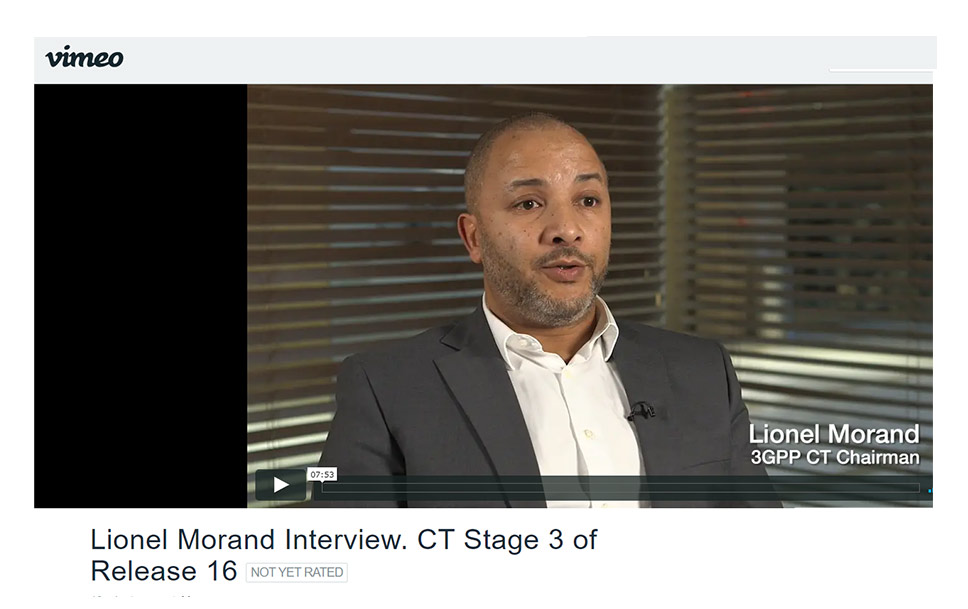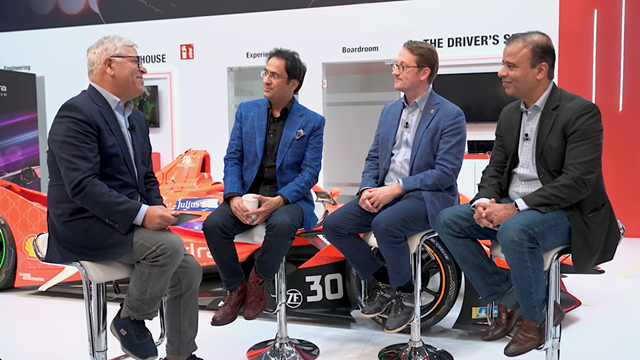January 15, 2020: In our latest video – filmed at the last Plenary meetings in Spain, December 12, 2019 - Lionel Morand speaks to Guy Daniels about the current priorities for TSG CT.
The interview covers the status of Release 16, with an explanation of what Stage 3 CT work is all about. It ends with a call to action for new experts – from vertical industries - to contribute to getting the protocol work for 5G features done.
Here is a transcript of the interview - which can be viewed on our Vimeo video site...here
Lionel Morand: CT, the Core network and Terminals Specification Group, provides the solutions and protocols for the core network to be able to inter-connect. So, it is the Stage 3 – the protocol – level. We need to define specifications that will enable signalling between all the entities and support mobility management, user data management and all the specific requirements that are needed for the core network.
GD: What do we mean by ‘Stage 3’?
 LM: In the organization, we are defining three stages. Stage 1 is what we call the ‘Service requirements’ level. We are defining there what needs to be supported by the System – We collect the requirements coming from different parties. We have the Operators and vendors, but also now we have a lot of ‘Verticals’, like those related to IoT, Automotive, railways and so-on.
LM: In the organization, we are defining three stages. Stage 1 is what we call the ‘Service requirements’ level. We are defining there what needs to be supported by the System – We collect the requirements coming from different parties. We have the Operators and vendors, but also now we have a lot of ‘Verticals’, like those related to IoT, Automotive, railways and so-on.
Stage 2 is more about taking the service requirements and deciding what kind of functionality we need to support in the system. It tries to shape commercia or market requirements to a more functional requirement that can then be used at the Stage 3 level – to be able to implement the solution in the network – to support the requirement.
GD: So, Release 16 is in Stage 3. When is it due for completion?
LM: I can speak for CT (non RAN), for the time being we are confident that we will complete the work in March (2020). We may have some exceptions, because we have some requirements coming in late and we will need to fulfil these requirements – to complete the Release, to provide a complete set of features. So, we may have some ‘exceptions’ until June 2020 – but, for the time being – After this Plenary (Sitges, December 2019 – TSG CT#86) the assumption is that 90% of the work will be finished by March – if not 100%.
GD: Why is it important to fully complete a Release?
LM: What we try to provide in 3GPP is a complete set of functionalities – that can be deployed and used in the network. We have the notion of ‘a Release’ to ensure that vendors, implementors, operators and third parties will know what to expect at the end of each release and they are able to use the product of 3GPP’s work to be able to implement it and to deliver services.
GD: Release 16 is the completion of 5G Phase 2, within 3GPP; bringing in massive MTC, ultra-reliable and low latency features. What is the next phase of work for you?
LM: We are trying now – with SA and RAN – to define what will be the content of the next release – Release 17 – What we can forsee, for the time being, will be a lot of new requirements from the verticals, including new verticals; like satellite. We have Fixed Broadband Access coming in too. We also still have a lot of requirements coming in for Mission Critical Services – which is still an important topic.
As always, CT will consider the requirements that have been first identified in SA and then in RAN and CT we will try to implement all of them for Release 17. GD: What are your main concerns still. What keeps you awake at night?
LM: For Release 17, we can see that there is a bunch of new types of requirements that we will need to support. Obviously, we will need to also maintain what we have already defines – So, maybe the workload could be difficult to manage, especially as we may need to complete the work (on the release) in less than one year. We normally have nine months (for Stage 3) , so it will be a challenge for us. Compared to SA and RAN – CT is a smaller group, with not so many delegates. Today we are really dependant on those (few) delegates, so adding more work will definitely be challenging for us.
GD: You talked about the need for a growth of cooperation, do we need a better anticipation of work as it progresses through SA, reducing the shock at the start of Stage 3 work?
LM: Yes, this is under our responsibility as TSG Chairs, so with RAN and SA we try to coordinate the work to see what is expected from the Service Requirement point of view – what will be needed at the functional level – and try to anticipate what will be the impact in the core network.
Before, it was just about mobile systems and it was voice centric. Now, we have a lot of different types of requirements and we need to cooperate – between the different 3GPP working groups just to be able to ensure that we are able to provide that complete set of functionalities for the release.
GD: Can you mention any specific plans, for the future, for the CT group?
LM: The next action – but not in the next (Rel-17) release – may be to see if we can have a new User plane. The one we have today is something that was defined already in 3G, reused in 4G and maybe with these new types of requirements for ultra-reliable and low latency …and some other specific requirements; we may need to enhance a little bit this user path and probably adopt a new solution for that.
Maybe the next step, for CT, would be to have something closer to the implementation. We are talking about Authorization and about Cloudification. When we are defining solutions at the protocol level, you need also to be aware of the software architecture that will be used behind the logical architecture and design our solution based on this.
GD: You say that CT is a relatively small group within 3GPP, but as you have additional Release 16 work and you have got the new Release 17 work coming along; how are you going to manage the increased workload?
LM: Compared to RAN and SA, we are relatively small and especially in SA – we have more people coming in from the verticals to push for extra requirements for support over the system. We are smaller, but we are seeing new delegates already, especially for Mission critical, or Vehicle to vehicle related requirements. It might not be enough and I think that for Release 17 we will need more people, so we welcome any additional new delegates in the CT working groups – to be able to support the workload, but not only that – Also, to gain from the expertise from these guys that have a lot of expertise regarding their services – that could be used when defining the protocol solution.
See the Video on the Vimeo web site...here
You can also watch the OSP featured video on TelecomTV
Email Newsletters
Sign up to receive TelecomTV's top news and videos, plus exclusive subscriber-only content direct to your inbox.



